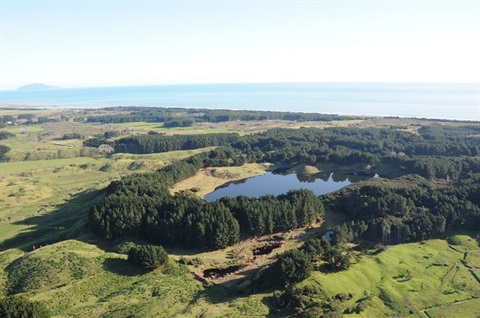25-year consent granted for Levin treated wastewater discharge
Published on July 08, 2020

A 25-year consent has been granted for the continued use of one of New Zealand’s original and most unique treated wastewater discharges.
Levin’s treated wastewater is discharged to land at what is locally known as The Pot – a 110-hectare pine and native forest plantation 7 km from Levin within the Waiwiri Catchment.
The resource consent application was submitted in 2018. The newly granted consent is the culmination of two years of extensive investigations examining the environmental effects of land discharge at The Pot.
A hearing on the application commenced in October last year, and the final decision to grant the consent was issued in June this year. Extensive engagement between submitters and the Council was noted by the hearing committee in their decision supporting the granting of consent.
“We commend the applicant for their willingness to work alongside submitters, particularly the tangata whenua as treaty partners, and the agreement made with the three hapū of Ngāti Raukawa, the MTA [Muaūpoko Tribal Authority] and the MLT [Muaūpoko Land Trust] is strong testament to this.”
The decision further stated that “the relationship of Māori and their culture and traditions with their ancestral lands, water, sites waahi tapu and other taonga” is both “recognised and provided for” in this decision by the agreement reached between tangata whenua and the applicant. “Moreover, we consider that the agreement reached between the tangata whenua and applicant in relation to the term and conditions of consent is an expression of Tino Rangatiratanga as envisaged by the principles of Te Tiriti o Waitangi.”
Horowhenua Mayor Bernie Wanden said the decision provides certainty for the community and comes after extensive engagement with landowners, Ngāti Raukawa, Muaūpoko and the community over the last six years.
“It is pleasing to see Council’s commitment to partnership with iwi being recognised in the resource consent decision. Acknowledgement should also be given to the partnering landowners, Muaūpoko Land Trust, who have worked constructively with Council.”
Horowhenua District Council Chief Executive David Clapperton said the consent process is part of a larger programme looking at the current and future management of Levin’s wastewater. Horowhenua District Council is proud to be leading the way with land-based discharges and aims to have all treated wastewater discharges going to land in a few years’ time.”
The consent comes with conditions, including a requirement for ongoing improvements for the Waiwiri Stream. This has given rise to research opportunities and works programmes including a partnership between Council and the Ministry for the Environment with a trial part funded by the Freshwater Improvement Fund, which seeks to determine if irrigating wastewater onto manuka/kanuka will improve water quality.
Council are also working with a Massey University PhD student to understand how groundwater may be further improved using wood chips. An iwi group will use the site to research and develop Mataraunga Māori (traditional monitoring) techniques to assess and monitor water quality changes over time.
Other operational and development initiatives include:
- additional environmental monitoring, including coastal monitoring;
- restoration of existing kanuka stands;
- rehabilitation of a previously-drained wetland and creating a new wetland;
- establishment of native vegetation;
- replanting of pines in some areas;
- establishment of a catchment programme to improve water quality in the Waiwiriri Stream; and
- investigation into appropriate land use in the catchment.
Mr Clapperton acknowledged the public’s increasing demand for improved water quality and said “we are hopeful the studies undertaken with regards to the kanuka/manuka forest and other measures will provide for improved water quality and demonstrate ways we can help others in our community and other communities.”
He also noted that Council is determined to provide the community with affordable and sustainable long term infrastructure. Receiving consent for 25 years is testament to the Council’s long term vision.